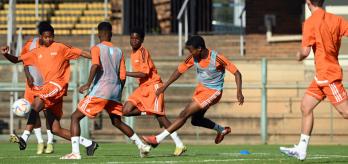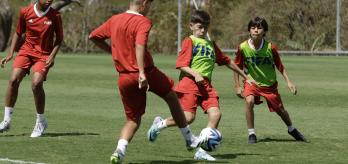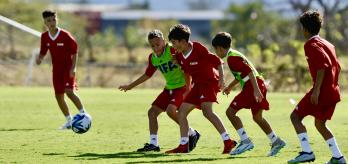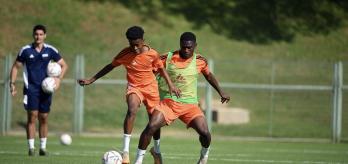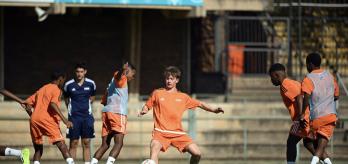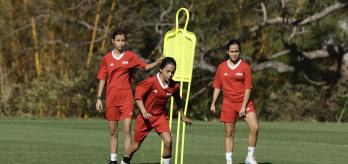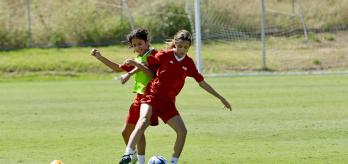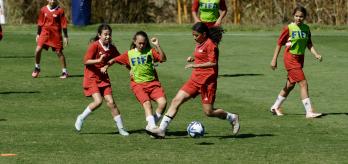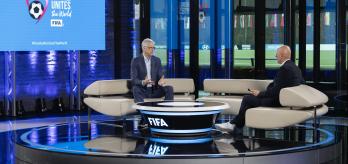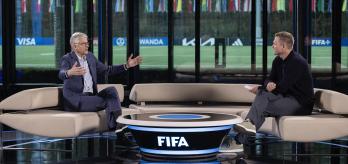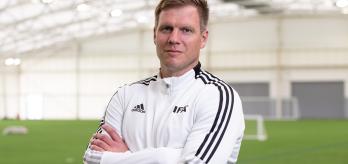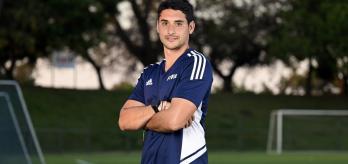Methodology
The intention: What is practised?
This 3v3 plus 3 possession game aims to improve a unit’s ability to organise its central block and pressing structure with a view to shutting off passing lanes that the opposition look to play through. The exercise focuses on unit-level aspects, such as applying a press in a three-player group in which two players jump out to press the ball and the other player provides cover to cut off passes that the opposition use to play through the defensive shape. The unit is tasked with reacting quickly to the defensive transition and working together to close down gaps inside its shape. The members of the unit are asked to regroup quickly at all times and to communicate which role in the press each other is to perform, as any lapses of concentration present the opposition with a chance to progress play.
The scale: For whom is this relevant?
This possession game revolves around the unit scale and focuses on the pressing team’s ability to block and prevent the opposition from progressing play. The exercise is relevant to a team that operate in a mid-block or apply a high press, and it focuses on the actions of the first or second line of defence. The two players who initiate the press may be attackers or wingers, and they force the opposition wide. The covering player (the third defender) may simulate a covering midfielder whose role is to stop the ball from reaching the opposition’s attacking players in central areas. The exercise is position-specific, with players challenged to press and pass the ball in a way that aligns with the role that they are performing.
The practice type: How is the practice designed?
This exercise is an opposed possession game that is contested in a reduced-sized exercise area. The drill aims to promote the implementation of an aggressive press in central areas. The main zones provide a reference point for the areas into which the in-possession team should play the ball and in which the defending team must press more aggressively. The central zone acts as a screening zone, and the player operating in the zone is asked to constantly adjust their position depending on where gaps and passing angles appear. The two-pass rule that applies to the in-possession team affords the defending team the time to organise their pressing structure and avoids play being constantly switched. The first variation enables the defending team to press in greater numbers, and the second variation helps them to react positively by advancing with the ball once they win it.
Session plan
Organisation
-
Mark out a 45m x 15m exercise area and split it into 5 zones lengthways: two 5-metre end zones, two 15-metre main zones and a 5-metre central interception zone.
-
Split the players into 3 teams of 3 (oranges, blues and greens).
-
Place the orange team in 1 of the main zones and the blue team in the other.
-
Set the green team up in the central interception zone.
Explanation
-
The exercise starts with a coach feeding a ball into the oranges or blues.
-
One green player must stay in the central interception zone at all times, while the other 2 green-team players leave the central zone and press the in-possession team inside their zone.
-
The in-possession team’s objective is to transfer the ball to the team occupying the other main zone by playing it through the central interception zone. They must complete 2 passes in their zone before being able to transfer the ball into the opposite zone.
-
If the greens win the ball, they play it into the opposite main zone, and the team that just lost possession become the defending team.
Variation 1
-
All 3 defending-team players can press the in-possession team in their zone.
Variation 2
-
Once the defending team have won the ball, they try to dribble it into, or link up to receive the ball in, the nearest end zone.
Key coaching points
Roles of coaches
-
First coach: explains the rules and objectives of the exercise.
-
Second coach: encourages the players and provides them with tips from their position along one of the two longer sides of the exercise area.
-
Third coach: feeds balls into the players from their position on the same side of the exercise area as the second coach.










